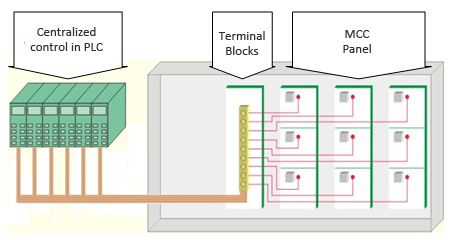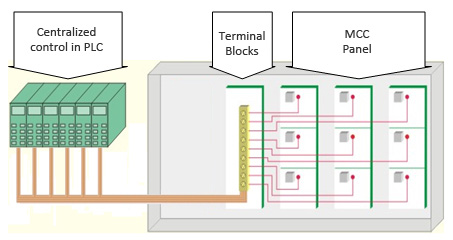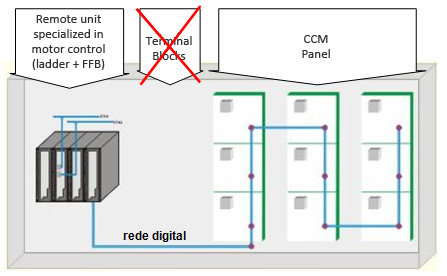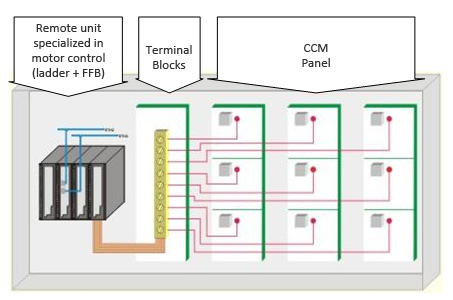
How to improve the Motor Control Center - MCC

Characteristics:
- Higher diagnostics availability;
- Better response time;
- Different integration methods;
- Reduced cabling and connections;
- Reduced total cost;
- Upgrade for existing plants.
Digital networks are now widely used and chosen as the main solution for communication in the Motor Control Center (MCC) to reduce installation costs and ensure access to more information.
But earlier MCC projects can still be found. In these systems, MCCs were always controlled and monitored by a PLC and inputs and outputs had to be connected point to point to this PLC.
As PLC and MCC were most times in a different location, large quantity of cabling and connections was necessary in conventional MCC, in addition to marshaling panels to rearrange cabling from MCC to PLC cabinets.
Conventional MCC
Maintenance for this installation type is also complicated and expensive, as long wiring takes more time to be repaired, in case of cabling rupture or malfunction.
Other problem with this approach is the poor MCC diagnostics, as not all signals derived from the MCC could be connected, to maintain an acceptable cost/benefit ratio.
An evolution of this system is the use of remote units to optimize the cabling. A high-speed network interconnects the remote PLC. However, the high number of connections is kept between the soft starters and variable frequency drives (VFDs) with the remote units, and the problem of the lack of diagnosis remains the same, as mentioned above.
Conventional MCC with remote I/OIn short, costs on this approach are high, so the connections need to be carefully selected, to reduce installation and material costs.
Smart MCC does not suffer from these disadvantages. On this configuration, PLCs, soft starters and VFDs are connected via digital network, reducing drastically all cabling and also eliminating the marshalling panel.
Smart MCCIn addition to reducing installation costs, another benefit of the “intelligent” MCC is the access to diagnostic data, controlled variable status and information on the presentation of variables (engineering units, methods, dependence relations, limits, etc.). Some examples of diagnostics obtained with intelligent MCC are:
- Operation mode (local/remote);
- Status (on/off);
- Error codes;
- Operation speed;
- Torque current;
- Voltage;
- Acceleration and deceleration times
- Parameterization;
- Maintenance.
The SMAR DFI302 is an open and safe solution for integration of smart MCCs because it is used with the SYSTEM302, a comprehensive system based on standards such as OPC, Modbus, DNP3, Profibus, DeviceNet, AS-i and Foundation Fieldbus (FF). The SMAR SYSTEM302 integrates in an easy and simple way the controllers of the industrial plant. The SYSTEM302 provides an asset management tool for diagnostics viewing and configuration of MCC devices.
The DFI302 is not just a remote I/O module, but a remote unit specialized in motor control, capable of performing local logic, where primary interlocks can be implemented in MCC cabinets and only the points of interest are sent to the main controllers. This feature saves processing time from the main CPU and increases overall response time of the system, since less data will be interconnected.
An old motor control center can be renewed to use the benefits of smart MCCs, but the investment to replace it completely for a new one can be prohibitive. To save considerable material and human effort, an option would be to upgrade existing MCCs using the DFI302 as a remote unit specialized in MCC control.
The DFI302 of SMAR connects the conventional signals to a high-level network such as Ethernet TCP/IP, providing redundancy and easy data integration.
MCC updated with specialized remote units
Characteristics
SYSTEM302 Availability
Physical Points (I/O)
1024
Virtual Points
4096
Modbus-RTU
1 port x EIA-232
Function Blocks
Up to 1200
Modbus Slave
Yes
OPC Support
Yes
DNP3 Support
Yes
Foundation Fieldbus HSE/Modbus TCP
2 ports x 10/100 Mbps
Vac Power Supply
90 to 264VAC
Vdc Power Supply
20 to 30VDC
Redundancy support
Yes
Related Topics:
For more information, please contact our local representatives.











